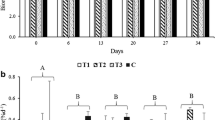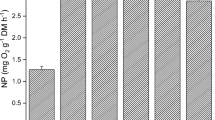Abstract
In a laboratory experiment, Ruppia drepanensis Tineo seedlings from a brackish marsh in Southern Spain were grown at 20 and 30 °C, at three different nitrogen levels. These levels were obtained by the addition of a slow release fertilizer (23% NH4NO3 by weight) to a sediment mixture of sand and clay (3:1). Several morphometric parameters were recorded during the first five weeks of the experiment, and photosynthesis and respiration were measured after 7 weeks of growth. Results showed a significant reduction of growth and development with increasing nitrogen and temperature levels. Dark respiration increased strongly at high nitrogen levels. At the same time, net photosynthesis at 250 and 500 µE m-2 s-1, Pm, Km and LCP were not affected by either factor. We attribute these phenomena to ammonia toxicity, since relatively high total ammonia (NH3 + NHf4 p+) levels were found in the interstitial water.
Similar content being viewed by others
References
APHA, AWWA & WPCF, 1975. Standard methods for the examination of water and wastewater. 14th edn., Washington, USA.
Barko, J. W. & R. M. Smart, 1981. Comparative influences of light and temperature on the growth and metabolism of selected submersed freshwater macrophytes. Ecol. Monogr. 51: 219–235.
Barko, J. K., D. G. Hardin & M. S. Matthews, 1982. Growth and morphology of submersed freshwater macrophytes in relation to light and temperature. Can. J. Bot. 60: 877–887.
Bloemendaal, F. H. J. L. & J. G. M. Roelofs, 1988. Schadelijke stoffen. In F. H. J. L. Bloemendaal & J. G. M. Roelofs (eds), Waterplanten en Waterkwaliteit. Natuurhistorische bibliotheek van de KNNV nr 45, Utrecht: 127–137.
Brinkman, A. G. & W. Raaphorst, 1986. De Fosfaathuishouding in het Veluwemeer. PhD Thesis, Twente University: 181–182.
Bulthuis, D. A. & W. M. J. Woelkerling, 1981. Effects of in situ nitrogen and phosphorus enrichment of the sediments on the seagrass Heterozostera tasmanica (Martens ex Aschers) den Hartog in Western Port, Victoria, Australia. J. exp. mar. Biol. Ecol. 53: 193–207.
Conway, G. R., N. R. Glass & J. C. Wolcox, 1970. Fitting nonlinear models to biological data by Marquardt's algorithm. Ecology 51: 503–507.
De Nie, H. W., 1987. The decrease in aquatic vegetation in Europe and its consequences for fish populations. EIFAC/CECPI ocassional Paper no. 19: 20–30.
García, C. M., J. L. Perez-Llorens, F. X. Niell & J. Lucena, 1991. Pigment estimations and photosynthesis of Ruppia drepanensis Tin. ex Guss. in a hypersaline environment. Hydrobiologia 220: 147–153.
Hootsmans, M. J. M. & J. E. Vermaat, 1991. Light response curves of Potamogeton pectinatus L. as a function of plant age and irradiance level during growth. In M. J. H. Hootsmans & J. E. Vermaat, Macrophytes, a key to understanding changes caused by eutrophication in shallow freshwater ecosystems. IHE Report Series 21: 57–130.
Iizumi, H. & A. Hattori, 1982. Growth and organic production of eelgrass (Zostera marina L.) in temperate waters of the Pacific coast of Japan. III. The kinetics of nitrogen uptake. Aquat. Bot. 12: 245–256.
Irisimah, N. O., D. R. Keeney & E. H. Dettman, 1976. Nitrogen cycling in Lake Wingra. J. envir. Qual. 5: 182–188.
Mattes, H. & K. Kreeb, 1974. Die Nettophotosynthese von Wasserpflanzen, insbesondere Potamogeton densus, als Indikator für die Verunreinigung von Gewässern. Angew. Botanik 48: 287–297.
Molongosky, J. J. & M. J. Klug, 1980. Anaerobic metabolism of particulate organic matter in the sediments of a hypereutrophic lake. Freshwat. Biol. 10: 507–518.
Novozamsky, I., V. J. G. Houba, R. van Eck & W. Van Vark, 1983. A novel digestion technique for multi-element plant analysis. Commun. in Soil Sci. Plant Anal. 14: 239–248.
Orth, R. J., 1977. Effect of nutrient enrichment on growth of eelgrass Zostera marina in the Chesapeake Bay, Virginia, USA. Mar. Biol. 44: 187–194.
Phillips, G. L., D. F. Eminson & B. Moss, 1978. A mechanism to account for macrophyte decline in progressively eutrophicated freshwaters. Aquat. Bot. 4: 103–126.
Pulich Jr., W. M., 1985. Seasonal growth dynamics of Ruppia maritima L. s.l. and Halodule wrightii Aschers. in Southern Texas and evaluation of sediment fertility status. Aquat. Bot. 23: 53–66.
Richardson, F. D., 1980. Ecology of Ruppia maritima in New Hampshire (USA) tidal marshes. Rhodora 82: 403–439.
Roberts, M. H., R. J. Orth & K. A. Moore, 1984. Growth of Zostera marina seedlings under laboratory conditions of nutrient enrichment. Aquat. Bot. 20: 321–328.
Roelofs, J. G. M., 1991. Inlet of alkaline river water into peaty lowlands: effects on water quality and Stratiotes aloides L. stands. Aquat. Bot. 39: 267–293.
Sand-Jensen, K., 1983. Photosynthetic carbon sources of stream macrophytes. J. exp. Bot. 34: 198–210.
Santamaria, L., M. J. M. Hootsmans, C. Montes & W. Van Vierssen, in press. Effect of bicarbonate availability and age on the primary production of Ruppia drepanensis from a Mediterranean brackish marsh. Verh. int. Ver. Limnol.
SP,S institute Inc., 1988. SAS/STAT User's Guide, Release 6.03 Edition. Cary, N.C.: 1028.
Short, F. T. & C. P. McRoy, 1984. Nitrogen uptake by leaves and roots of the seagrass Zostera marina. Bot. mar. 27: 547–555.
Søndergaard, M., 1990. Pore water dynamics in the sediment of a shallow and hypertrophic lake. Hydrobiologia 192: 247–258.
Thursby, G. B. & M. M. Harlin, 1984. Interaction of leaves and roots of Ruppia maritima in the uptake of phosphate, ammonia and nitrate. Mar. Biol. 83: 61–67.
Van der Eerden, L. J. M., 1982. Toxicity of ammonia to plants. Agric. Envir. 7: 223–235.
Vermaat, J. E. & M. J. M. Hootsmans, 1991. Growth of Potamogeton pectinatus in a temperature-light gradient. In M. J. M. Hootsmans & J. E. Vermaat, Macrophytes, a key to understanding changes caused by eutrophication in shallow freshwater ecosystems. IHE Report Series 21: 28–56.
Vines, H. M. & R. T. Wedding, 1960. Some effects of ammonia on plant metabolism and a possible mechanism for ammonia toxicity. Plant Physiol. 35: 820–825.
Warren, K. S., 1962. Ammonia toxicity and pH. Nature 195: 47–49.
Westlake, D. F., 1967. Some effects of low-velocity currents on the metabolism of aquatic macrophytes. J. exp. Bot. 18: 187–205.
Author information
Authors and Affiliations
Rights and permissions
About this article
Cite this article
Santamaría, L., Dias, C. & Hootsmans, M.J.M. The influence of ammonia on the growth and photosynthesis of Ruppia drepanensis Tineo from Doñana National Park (SW Spain). Hydrobiologia 275, 219–231 (1994). https://doi.org/10.1007/BF00026713
Issue Date:
DOI: https://doi.org/10.1007/BF00026713




